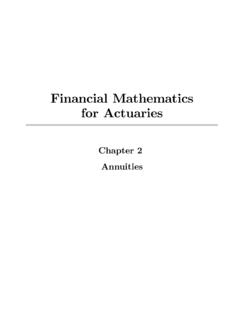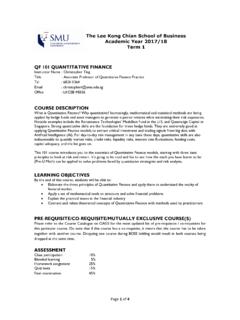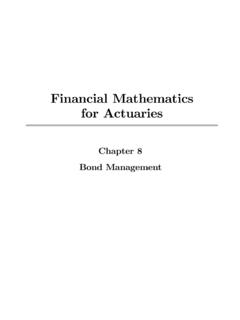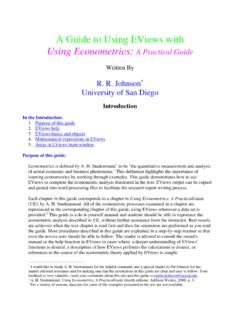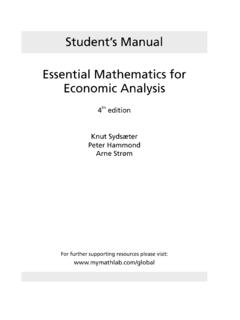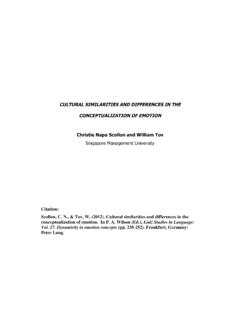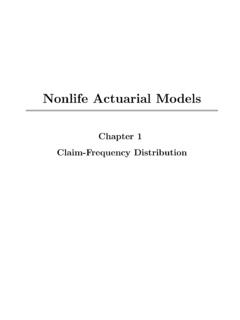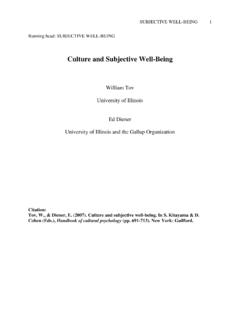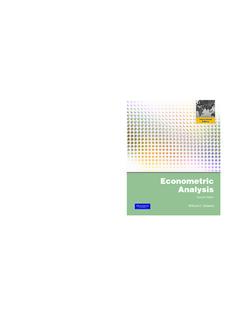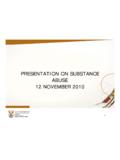Transcription of New Measures of Well-Being - mysmu.edu
1 New Measures of well -BeingEd Diener, Derrick Wirtz, Robert Biswas-Diener, William Tov,Chu Kim-Prieto, Dong-won Choi, and Shigehiro OishiAbstractWe present new Measures of Well-Being to assess the following concepts:1. Psychological Well-Being (PWB); 2. Positive Feelings, Negative Feelings, andthe balance between the two (SPANE-P, N, B); and 3. Positive Thinking. The PWBscale is a short 8-item summary survey of the person s self-perceived functioningin important areas such as relationships, self-esteem, purpose and meaning, andoptimism. The scale is substantially correlated with other psychological well -beingscales, but is briefer. The scale provides a single overall psychological well -beingscore and does not yield scores for various components of Well-Being . The Scale ofPositive and Negative Experience (SPANE) yields a score for positive experienceand feelings (6 items), a score for negative experience and feelings (6 items), andthe two can be combined to create an experience balance score.
2 This 12-item briefscale has a number of desirable features compared to earlier Measures of positiveand negative feelings. In particular, the scale assesses with a few items a broad rangeof negative and positive experiences and feelings, not just those of a certain type,and is based on the frequency of feelings during the past month. A scale to measurePositive Thinking is also presented. Basic psychometric statistics are presented forthe scales based on 573 college students at five Measures of well -BeingWhen examining the standard scales for assessing Well-Being , we were impressedwith the need for measurement scales in several domains positive and negativefeelings, positive thinking, and a brief scale of psychological Well-Being (PWB).E. Diener (B)Department of Psychology, University of Illinois, Urbana-Champaign, Champaign, IL 61820, USAe-mail: scale in this article entitled Psychological Well-Being has since been renamed as the Flourish-ing Scale.
3 Further psychometrics and other data concerning the scale can be found in the article:Diener, E., Wirtz, D., Tov, W., Kim-Prieto, C., Choi, D., Oishi, S., & Biswas-Diener, R. (2009).New Measures of Well-Being : Flourishing and Positive and Negative Diener (ed.),Assessing Well-Being : The Collected Works of Ed Diener,Social Indicators Research Series 39, DOI ,C Springer Science+Business Media 2009247248E. Diener et concepts are related to one another and to life satisfaction, although thetypes of Well-Being are separable (Lucas, Diener, & Suh, 1996; Ryff, 1989) andmust, therefore, be assessed separately. Although scales exist to measure severalof these constructs, the instruments have limitations that make additional measuresdesirable. We present a short measure of psychological Well-Being (PWB) designedto complement the longer scales that are available and a measure of negative andpositive feelings that is designed to better assess ongoing feelings of Well-Being .
4 Aninitial scale to assess positive thinking contains both positive and negative items. Wepresent the psychometric properties of the scales, such as reliabilities and convergentcorrelations with other relevant scales in this chapter are similar to Measures that were first presented inDiener and Biswas-Diener sHappiness: Unlocking the Mysteries of PsychologicalWealth(2008). Several items were altered or dropped, and we report here psycho-metric analyses that examined features of the revised scales such as internal andtemporal reliability, factor structure, discriminant validity of the scales from oneanother, and convergent validity with other similar scales. The Measures in thischapter, and their shortened names, are:Positive Experience (SPANE-P)Negative Experience (SPANE-N)The Balance of Positive and Negative Experience (SPANE-B)Positive Thinking (PTS)Psychological Well-Being (PWB)Why New Scales?Positive and Negative FeelingsScales exist to assess pleasant and unpleasant emotions, and probably the mostwidely used is Watson, Clark, and Tellegen s (1988) Positive and Negative AffectSchedule, called the PANAS.
5 There are several limitations of this measure thatmotivated us to develop an alternative scale to assess pleasant versus unpleasantfeelings. The PANAS was designed to measure a specific conception of emotionalwell-being and ill-being, and thus assesses some states that are usually not consid-ered to be feelings. In addition, the scale fails to measure a number of importantpositive and negative feelings that are considered to be important to Well-Being . Forexample, the Positive Affect items of the PANAS include strong, alert, active, and determined, which many would not consider to be feelings. One can feel active and alert if one is scared, and strong when one does not feel emotional. Determined can be seen as a motivational state, but is not necessarily a pleasantor desirable one in all instances. For example, respondents might be determined because they are angry and vengeful. In addition, some feelings on the PANAS,such as inspired, are rare and very specific.
6 Thus, the scale does not with certaintyreflect feelings that will enhance Measures of well -Being249 The Negative Affect items include many adjectives that are more widely agreedto be emotional experiences, but some feelings are notable by their absence. Forexample, the scale does not include sad or depressed, which are core nega-tive feelings. Indeed, the depression facet of neuroticism predicts life satisfactionbetter than all facets of neuroticism ( , anxiety, anger, vulnerability) combined(Schimmack, Oishi, Furr, & Funder, 2004), suggesting the centrality of sad and depressed in understanding people s Well-Being . Furthermore, some feelings arerepresented by a number of similar adjectives, such as jittery, nervous, scared, and afraid. The inclusion of four synonyms for anxiety means that the scale isheavily weighted with one specific type of feeling. Thus, fully forty percent of theitems represent various forms of fear, whereas sadness is not represented at derives from the fact that Watson and colleagues consider negative feelingsto be both negative and aroused, and, therefore, unaroused, unpleasant feelingswere omitted from their scale.
7 Thus, the PANAS represents a narrow definitionof positive and negative feelings based on highly aroused forms of these , Well-Being and ill-being include many feelings that are not of the highlyaroused reviewed above, there are a number of important feelings that are omittedfrom the PANAS. For example, love and other terms referring to affectionate feel-ings are usually considered to be important emotions but are omitted from thePANAS. Feelings such as pride, envy and jealousy, contentment, joy, and happi-ness are not assessed. Although the expanded PANAS-X (Watson & Clark, 1994)includes many of these feelings, this scale is not used frequently in the well -beingfield, in part because of its length, and in part because it Measures attentiveness, jovi-ality, and self-assurance that are not precisely the types of feelings that well -beingresearchers want to important shortcoming of the PANAS and other existing scales is theproblem that they omit feelings that might be important in some cultures or to cer-tain individuals.
8 For example,schadenfreudeis an emotion that is often mentionedas a German emotion-word for which there is no word in English. Scollon, Diener,Oishi, and Biswas-Diener (2004) mention words such as sukhi and aviman inIndia and shitashima and fureai in Japan, which do not exist in English or inmany other cultures. Furthermore, East Asians deem low-arousal positive emotionssuch as calm and relaxed to be more desirable than North Americans do (Tsai,Knutson, & Fund, 2006), suggesting that low arousal positive emotions that aremissing from the PANAS might be important correlates of Well-Being in other cul-tures. Finally, high arousal positive emotions are stronger predictors of life satisfac-tion among sensation seekers than among non-sensation seekers, on weekends thanon weekdays, and when the concept excitement is experimentally primed thanwhen the concept peace is primed (Oishi, Schimmack, & Colcombe, 2003). Insum, the PANAS is limited in that it includes descriptors that are not feelings andomits other feelings that are widely believed to be core emotional feelings, as wellas emotions that are important in some cultures, to some individuals, and in certainsituations.
9 The scale does not reflect the difference in the desirability of feelings indifferent contexts and Diener et example of why the adequate sampling of feelings is essential for an adequatemeasure of Well-Being can be offered based on a hypothetical comparison of youngand old adults. On the PANAS positive emotions scale, young adults might scorehigher than the elderly simply because they are more energetic and lead lives that aremore active and arousing. Young people are likely to score higher on terms such as active and strong, even if they feel no more positive than old people. In contrast,the elderly might score higher on pleasant terms such as contented and happy, although these feelings are not assessed by the PANAS. Thus, the PANAS mightyield conclusions that would be completely reversed if a different set of adjectiveswere employed. The PANAS assesses highly activated or aroused states rather thanthe full range of pleasant/desirable and unpleasant/undesirable of other scales designed to measure positive and negative feelings?
10 Lucas, Diener, and Larsen (2003) review Measures of positive emotions, includingthe PANAS and other scales. Several of the scales they review are very long, andeach of them suffers from certain deficiencies. For example, some of the scales arebased on a checklist format that yields less reliable results, and several of the scalesmeasure concepts such as surprise, joviality, and vigor that do not adequately samplethe positive feelings composing conclusion, we created a scale called the Scale of Positive and Negative Expe-rience, or SPANE for short. The SPANE brief name is followed by a P, N, or B toindicate the scales for Positive Experience, Negative Experience, and the Balancebetween the two. The SPANE includes broad descriptors for positive and negativefeelings, as well as a number of positive and negative emotions that are central tothe experience of can we avoid the omission of feelings, which is a major shortcoming of thePANAS, and include all positive and negative feelings without making an exhaustivelist that would create a scale that is prohibitively long?
